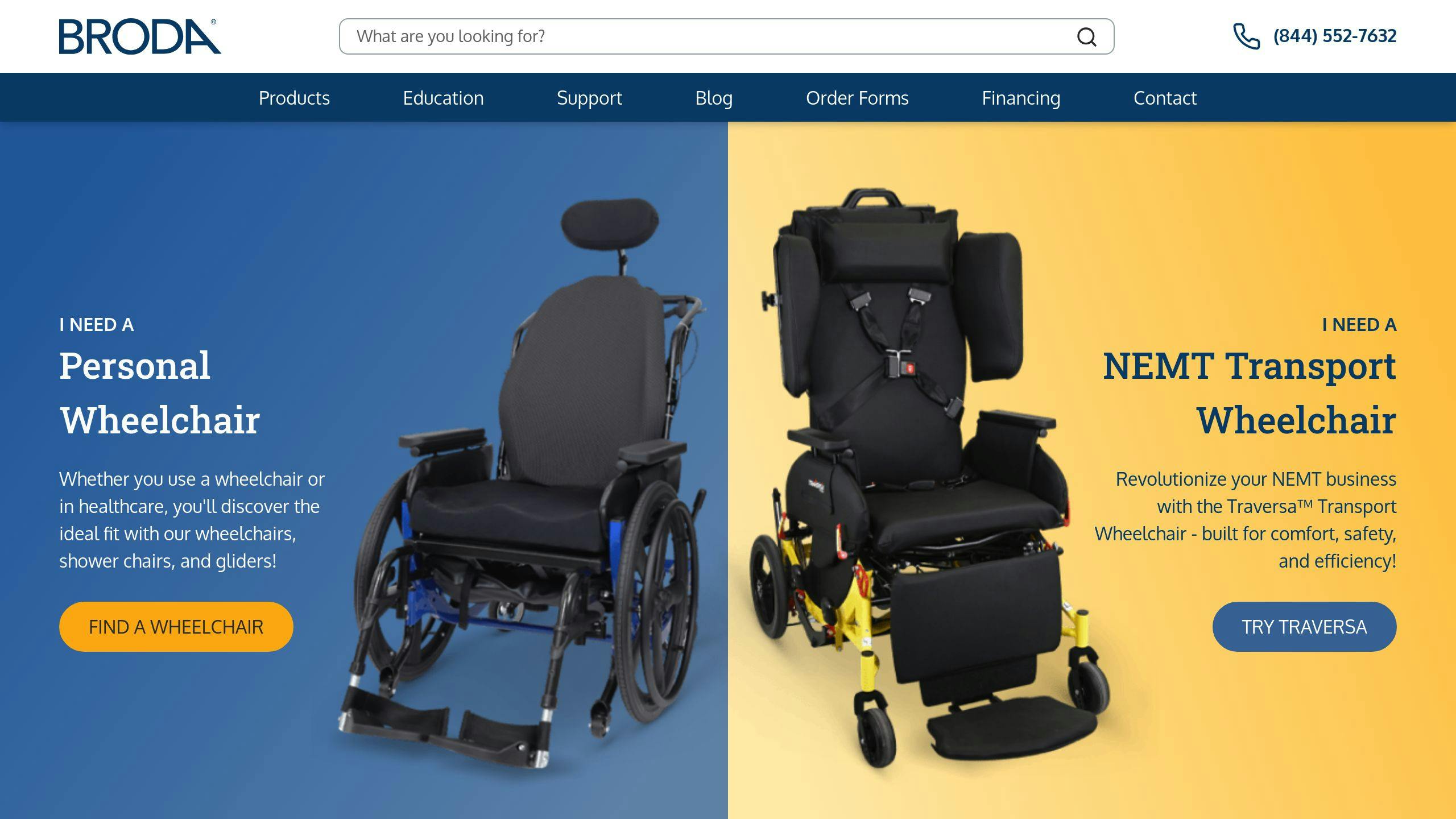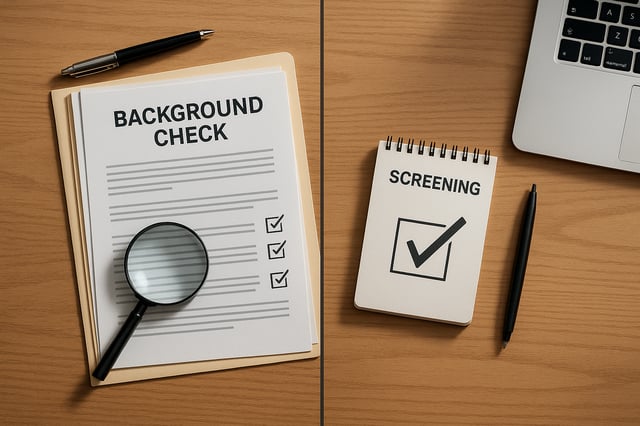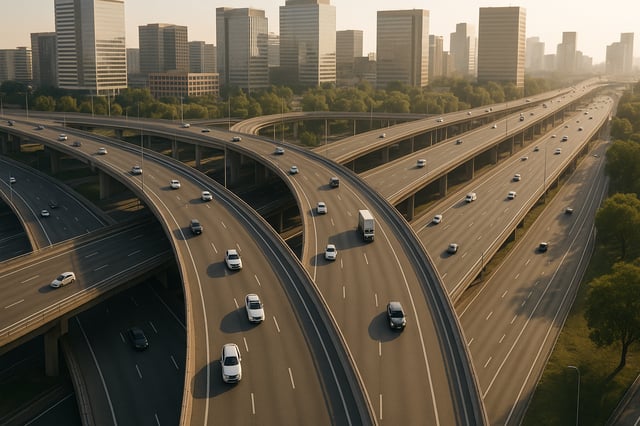

NEMT Entrepreneur provides expert insights, strategies, and resources to help non-emergency medical transportation professionals grow their businesses. Get industry-leading advice to succeed in NEMT.
Featured articles
Running a successful Non-Emergency Medical Transportation (NEMT) business in 2025 requires more than just vehicles. To stay competitive, you’ll need advanced tools and technology that improve efficiency, meet regulations, and enhance patient satisfaction. Here's a quick breakdown of the must-haves:
- Wheelchair Lifts: ADA-compliant, smooth operation, and equipped with smart features like emergency backups and maintenance tracking.
- GPS Tracking Systems: Real-time tracking, route optimization, and detailed reporting to cut costs and improve service.
- Telematics: Monitors vehicle health and driver behavior, reducing accidents, fuel costs, and maintenance issues.
- Safety Tools: Advanced safety systems (e.g., emergency communication, monitoring) to protect passengers and reduce incidents.
- Multi-Purpose Equipment: Tools like Broda chairs that simplify patient transfers and reduce the need for extra equipment.
Quick Comparison of Key Equipment
| Equipment Type | Key Features | Business Impact | ROI Timeline |
|---|---|---|---|
| Wheelchair Lifts | Smart tracking, quiet operation | Better accessibility, fewer issues | 24-36 months |
| GPS Tracking Systems | Real-time alerts, route planning | Lower fuel and operating costs | 6-12 months |
| Telematics | Driver monitoring, maintenance alerts | Fewer repairs, safer operations | 12-18 months |
| Safety Equipment | Emergency response, risk management | Fewer breakdowns, lower insurance | 18-24 months |
| Broda Chairs | Adjustable, versatile functionality | Simplified transport, cost savings | Immediate |
Investing in the right mix of equipment is essential to keeping costs low, meeting industry standards, and improving service quality. With the NEMT market expected to grow significantly by 2028, staying ahead with these tools will set you up for long-term success.
Related video from YouTube
1. Wheelchair Lifts with Advanced Features
The market for vehicles with wheelchair lifts is booming - growing at 8.62% each year through 2028. This surge shows how NEMT services are racing to meet the rising need for better mobility options.
Top manufacturers like BraunAbility and AMF Bruns America are pushing the boundaries with their lift systems. They're not just meeting standards - they're setting new ones.
While ADA rules say lifts must handle 600 pounds and work with different wheelchair types, today's NEMT companies are going above and beyond. Here's what makes modern lift systems stand out:
- Smart maintenance tracking
- Digital safety systems
- Quiet, smooth operation
- Emergency power backups
These improvements mean fewer breakdowns and better service - key factors that affect ratings and help win new contracts.
"The NEMT industry is shifting towards more specialized and comfortable transportation solutions, with wheelchair-lift-equipped vehicles becoming the fastest-growing segment in the market", notes recent industry research.
Looking to invest? Check out the Mercedes-Benz Sprinter and Freedom Motors USA vehicles. They come with top-notch lift systems plus extras like automatic doors and better stability control. Yes, they cost more upfront, but they're worth it - you'll spend less on repairs, the equipment lasts longer, and passengers are happier.
But remember: while great wheelchair lifts make transportation accessible, you'll also need solid GPS tracking to keep your operations running smoothly.
2. GPS Tracking Systems for Better Navigation
GPS systems have become must-have tools for NEMT fleet management. They're not just about getting from A to B anymore - they're changing how providers run their entire operations.
Think of GPS as your fleet's command center: it handles everything from finding the best routes to keeping tabs on vehicles in real-time. Yes, you'll need to spend some money upfront on good GPS tech, but here's the thing: you'll save way more in the long run through better fuel use and smarter operations.
"Data-driven decisions are now essential in NEMT operations", emphasizes NEMTAC (Non-Emergency Medical Transportation Accreditation Commission). "GPS tracking systems deliver essential data for operational improvements."
Here's what modern GPS brings to NEMT providers:
| Feature | Business Impact |
|---|---|
| Real-time tracking + alerts | See your fleet 24/7 and handle emergencies faster |
| Smart reporting + routing | Meet regulations easily and cut operating costs |
| Best-route planning | Use less fuel and complete more trips |
| Quick alerts | Help passengers faster and keep them safer |
Let's look at a real example: Veyo shows what good GPS can do. They put advanced tracking in all their vehicles, and the results? Shorter trips and happier customers. Their dispatchers can see every vehicle's location as it happens, switch routes on the spot, and handle schedule changes right away.
Here's a pro tip: While basic GPS units might seem cheaper at first, going for a full-featured tracking system is the smarter move. It'll save you money through better efficiency and lower running costs. Make sure to pick a system that gives you detailed reports and works well with your other fleet management tools.
Want to take it further? Hook your GPS up with telematics systems - it's like giving your fleet a superpower boost.
3. Telematics Technology for Fleet Management
Think of telematics as your fleet's health monitor - it tracks everything from harsh braking to engine performance, helping you spot issues before they become problems. It builds on basic GPS tracking to give you a complete picture of how your NEMT fleet is doing, with real-time updates on vehicles, drivers, and maintenance needs.
Here's what makes modern telematics a game-changer: It cuts accidents by 15-20% through driver monitoring, which leads to lower insurance costs. You'll spend 30% less on repairs thanks to early maintenance warnings. Plus, you can trim fuel costs by 10-15% with real-time tracking.
"The future of NEMT will rely on providers who can not only capture this data but use it to increase their operational efficiency."
Take Samsara, for example. Their system shows what's possible in NEMT operations - they combine live vehicle health checks with smart maintenance scheduling, helping providers keep their service quality high while spending less money.
Want to stay on top of NEMTAC standards? Telematics does the heavy lifting. It automatically records vehicle checks, tracks service time, and confirms when you pick up passengers. You'll know right away if a vehicle needs attention, so your patients get reliable service every time. The system works with your dispatch setup, makes audits easier, helps cut fuel waste, and shows you where drivers might need extra training.
While telematics keeps your fleet running like clockwork, you'll still need safety tools to protect everyone on board during trips.
sbb-itb-cef70f4
4. Safety Tools for NEMT Vehicles
In 2025, NEMT providers are stepping up their game with better safety equipment to keep both passengers and drivers protected.
Let's look at what's making waves in NEMT safety right now:
| Safety Feature | Primary Benefit | Impact on Operations |
|---|---|---|
| Advanced Vehicle Safety Systems | Accident Prevention | 15-20% reduction in incidents |
| Emergency Communication Platform | Faster Response Time | 50% quicker emergency response |
| Real-Time Safety Monitoring | Proactive Risk Management | 30% improvement in safety scores |
| Automated Maintenance Alerts | Mechanical Failure Prevention | 25% fewer breakdowns |
Modern NEMT vehicles now come with communication systems that connect directly to dispatch and emergency services. When something goes wrong, help arrives faster. This boost in safety makes passengers feel more secure, which means they're more likely to stick with the service and renew contracts.
NEMTAC's certification programs have become a must-have in the industry. These programs teach drivers more than just how to use safety gear - they learn exactly what to do when emergencies pop up. Plus, smart alert systems help catch mechanical issues before they turn into problems.
Want to see safety done right? Check out the Toyota Sienna and Mercedes-Benz Sprinter. These vehicles come packed with features like automatic emergency braking, lane departure warnings, and blind-spot monitoring - must-haves for NEMT fleets in 2025.
By connecting these safety tools to telematics systems, NEMT providers can track everything from how the vehicle's running to how safely it's being driven. This helps them stay on top of industry rules while keeping operations smooth.
"The future of NEMT safety lies in the integration of advanced technology with traditional safety measures", notes a recent NEMTAC conference presentation. "Providers who invest in comprehensive safety solutions see up to 20% fewer incidents and improved compliance rates."
Beyond just safety gear, providers are also using equipment like Broda chairs to make rides more comfortable and accessible for passengers.
5. Multi-Purpose Equipment Like Broda Chairs

Broda chairs are changing how NEMT services handle patient transport. These smart solutions cut costs by replacing multiple pieces of equipment while keeping safety the top priority.
Here's what makes Broda chairs stand out:
| Equipment Capability | Operational Impact | Business Benefit |
|---|---|---|
| Height Adjustment | Matches medical equipment heights | Reduces transfer risks |
| Safety Features | Secure patient positioning | Lower injury risk |
| Versatile Positioning | Multiple configurations | One device, many uses |
Think of a Broda chair as a Swiss Army knife for patient transport. It handles everything from getting patients in and out of vehicles to moving them at medical appointments. This means you need less equipment and storage space. Plus, since these chairs adjust to different heights and support various weight ranges, you won't need as many specialized vehicles in your fleet.
"The integration of multi-purpose equipment like Broda chairs represents a significant advancement in NEMT operations, allowing providers to meet NEMTAC's new industry standards while improving operational efficiency"
NEMT providers are getting smart about combining Broda chairs with their safety systems. This fits perfectly with NEMTAC's focus on better patient transport methods, helping companies stay ahead while giving patients better care.
Looking to upgrade your equipment in 2025? Multi-purpose solutions like Broda chairs aren't just about solving today's problems - they're about getting ready for what's next in patient transport, especially as technology plays a bigger role.
The move toward multi-purpose equipment is just one piece of the puzzle. Let's look at what else is shaping NEMT's future.
Comparing Equipment Options for NEMT Providers
Smart equipment choices can make or break your NEMT business. Let's look at what different options cost and what they can do for your operation.
| Equipment Type | Initial Cost | Monthly Operating Cost | ROI Timeline |
|---|---|---|---|
| Wheelchair-Accessible Van (e.g., Ford Transit with BraunAbility lift) | $40,000-$100,000 | $200-$400 | 24-36 months |
| GPS Fleet System | $300-$500/unit | $20-$50/vehicle | 6-12 months |
| Telematics Package | $500-$1,000/vehicle | $20-$100/vehicle | 12-18 months |
| Safety Equipment Bundle | $1,500-$2,000/vehicle | $30-$50/vehicle | 18-24 months |
While wheelchair-accessible vans need more money upfront ($40,000-$100,000), they're must-haves for serving different patient needs. GPS fleet systems offer the quickest return, paying for themselves in just 6-12 months.
"The future of NEMT will rely on providers who can not only capture this data but use it to increase their operational efficiency." - Roundtrip Health, 2024 NEMTAC Transform Conference Insights
Here's what the numbers tell us: Telematics might seem pricey at first, but it pays off big time - cutting fuel costs by 15-20% and reducing maintenance problems by 30% in year one. GPS systems help you plan better routes and track performance, which directly helps your bottom line.
Safety matters for your wallet too. A full safety package (backup cameras, patient restraints, emergency buttons) runs about $1,500-$2,000 per vehicle. But here's the good part: it can lower your insurance costs by 20-30%.
With NEMT expected to hit $15.58 billion by 2028, it's smart to pick equipment that can grow with your business and meets NEMTAC standards. The key is finding the right mix of equipment that works for your budget today while setting you up for tomorrow's opportunities.
Emerging Trends in NEMT Equipment
The NEMT industry is getting a major tech upgrade for 2025. Take the Ram ProMaster's new all-electric model - it cuts operating costs by 30-40% while helping the environment. NEMT companies are also switching to energy-efficient lights and eco-friendly materials inside their vehicles to stand out in the market.
But it's not just about electric vehicles. Modern NEMT vehicles now come packed with data systems that handle scheduling in real-time and connect with patient records. At the 2024 NEMTAC Transform Conference, experts put it this way:
"The future of NEMT lies in comprehensive data analytics and AI integration, enabling providers to optimize routes, improve resource allocation, and enhance the overall patient experience."
Here's what's changing the game in NEMT:
| Tech Solution | Results | Expected Use by 2025 |
|---|---|---|
| AI Scheduling | 20% better efficiency | 60% of providers |
| CAD-EHR Systems | 40% less paperwork | 45% of operations |
| Electric Vehicles | 30-40% cost savings | 25% of new fleet purchases |
AI scheduling is making waves by matching drivers to rides more effectively, cutting down how long patients wait, and tweaking routes on the fly based on traffic and other factors. When Computer-Aided Dispatch (CAD) teams up with Electronic Health Records (EHR), everything moves faster with fewer mistakes, making the service better for everyone.
For NEMT providers, success means picking the right mix of these new tools - ones that boost both their bottom line and patient care quality.
Conclusion
Getting the right tools for NEMT vehicles in 2025 isn't just about keeping up - it's about staying in business. The NEMTAC Transform Conference showed how digital tech is reshaping the NEMT field:
"The NEMT industry is branching out to fulfill service gaps brought on by the pandemic, while patient treatment has moved exponentially to technology-based Telemedicine."
Let's look at what's driving change in the industry:
| Equipment Type | Effect on Business | Current Usage |
|---|---|---|
| Digital Systems (scheduling software, EHR integration) | 40% less paperwork | 45% of providers |
| Electric Vehicles | 30-40% cost reduction | 25% of new fleets |
| Advanced Mobility Tools | 8.62% market growth | Fastest growing segment |
These numbers tell a clear story: providers need to pick their equipment carefully to keep costs down and service quality high. Those who embrace new tech and run smooth operations will lead the way in healthcare transportation come 2025.
Think of it like upgrading your smartphone - you wouldn't want to run a modern business on a flip phone from 2005. The same goes for NEMT providers: using outdated equipment means getting left behind in today's fast-moving market.


